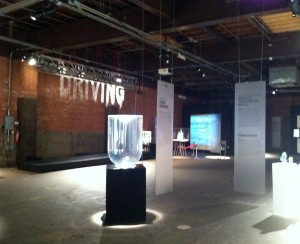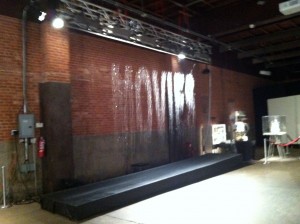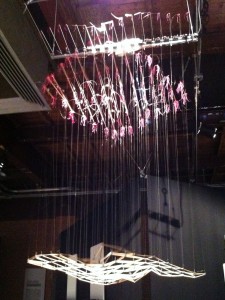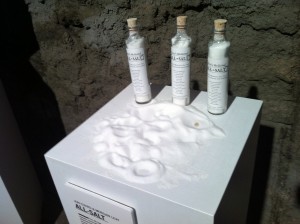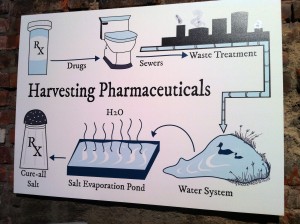Surface Tension: The Future of Water is, by far, the best exhibition of art & science-related work I’ve seen in the last several years. Curated by Ralph Borland, Michael John Gorman, Bruce Misstear and Jane Withers, the show originates at the Science Gallery at Trinity College in Dublin, Ireland, and is now on view at Eyebeam Art + Technology Center in New York City Chelsea district. Bringing together work by international artists and scientists to explore the future of water, the pieces in the exhibition examine water’s physical properties, its role in economics and politics, and some of the ways in which it may be harnessed, cleaned, distributed and (possibly) even rationed.
Potable water, which comprises only 1% of the Earth’s water, is the main focus of the projects on display, as are potential ways to clean up the plastic waste, oil spills and general contaminates now always present in the other 99% of the Earth’s water supply.
Without question, the dominant piece in the gallery is Julius Popp’s BIT.Fall. This installation converts pixels to drops of water, which fall in sheets from ceiling to
flow, creating rapidly descending text in mid-air. Each three foot-high word glitters in midair like strung cut crystals and hits the collection pad below with a thunderous rush. The rhythmic sound of the rain echoes throughout the exhibition space. The words themselves are culled in real time from prominent newspapers and reflect the news of the day. A disconnect for me, however, is the fact that the text itself doesn’t concern the subject of water. My conceptual preference for this work would be to have it harvest current information on the topic of water from Google or another search engine. It would seem apropos for this transient printer to keep us up-to-date on this most precious commodity.
Tele-Present Water, by David Bowen is another formally beautiful sculpture in the exhibition that does keep us connected to what’s happening to the other 70% of the Earth’s surface. The work is a floating horizontal grid suspended by numerous marionette wires. The grid itself undulates in real-time syncopation with a floating buoy, creating in the gallery the wonderfully fluid repetition with variations that the surface of a sea makes. While at the show I had the pleasure of meeting Sarah Quinn, one of the exhibition’s organizers from Dublin. She mentioned that, in a wonderfully poetic mishap, the buoy’s locator failed and, as of now, it has gone uncharted—leaving the live feed of its choreography the sculpture’s only connection to its floating/traveling doppelganger.
All-Salt, a meditation on our tainted bodily fluids, is equally poetic, albeit in a much darker way. Jon Cohrs and Morgan Levy, the artist team, present small tubes of salt harvested from the salt flats of San Jose’s Silicon Valley in California. This once clean salt commodity now contains significant amounts of pharmaceuticals—a testament not only to the circular- fluid processing of the Bay Area’s waste water, but also to the wide variety of medications taken by its citizenry, which end up in the local waterways. The didactic posted next to these tubes of white powder cheerfully tells us that, with so many accumulated pharmaceuticals, this salt is sure to cure whatever our ailments might be.
While several pieces in the show are allegorical in nature, others fall into the category of design and innovation. One is the open-source prototype boat Protei 002. Created by the team Protei, Protie 002 is a sailing ship designed to clean up oil spills with a long, absorbent polypropylene tail. While this vessel is due to be tested soon, other innovative works in the exhibition are still in the realm of conjecture.
My favorite effort, in this last category, is The Sea Chair Project, the architects of this effort are Kieren Jones, Alexander Groves, and Azusa Murakami. This work intends to create sailing vessels that are able to harvest plastic out of the ocean. Once brought on board, this harvest is recycled into raw material for injection molding and subsequently turned into plastic chairs. I love their idea of viewing the Great Pacific Garbage Patch, the toxic “plastic soup” that extends over an area twice the size of the United States, as a tangible resource. Wouldn’t it be wonderful if all of our plastic could come from this supply?
Good work and congratulations to everyone involved in Surface Tension.
Jon Cohrs, one of the creators of All-Salt, and author of the blog https://www.anewfuckingwilderness.com/ will be giving a talk for me at the SkypeOnArt Spring 2012 lecture series at Rutgers University on Oct. 29th, 12:30 at the Stedman Center for the Arts.
Info on Surface Tension: https://eyebeam.org/events/summer-exhibit-surface-tensionInfo on Eyebeam: https://eyebeam.orgLink to Science Gallery at Trinity College Dublin: http://dublin.sciencegallery.com/
